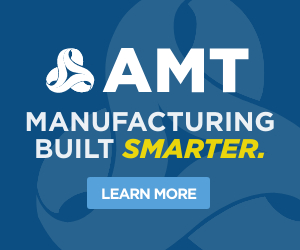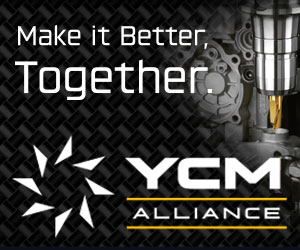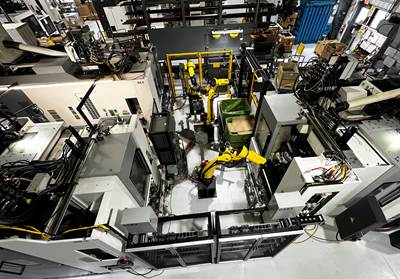Increasing Productivity with Digitalization and AI
Sponsored ContentJob shops are implementing automation and digitalization into workflows to eliminate set up time and increase repeatability in production.
Share
Shop owners today are spending more time focusing on efficiency, repeatability and automation using digital tools such as AI, or artificial intelligence. From large production facilities to businesses with a handful of employees, creating efficiencies in workflows is top of mind and is the key to growing profitability. IMTS 2024, September 9-14, at McCormick Place in Chicago, offers visitors access to exhibitors with a wide swath of technology to help achieve these goals. We spoke with a few different companies to find out what they’re already doing today with AI, and what they’re hoping to learn and explore at the show.
High Production Shop Seeks Engineering and Documentation Solutions
Major Tool a nearly 80-year-old company based in Indianapolis, Indiana, is a contract manufacturer specializing in CNC milling and turning machining, as well as welding, engineering, inspection and assembly specializing in very large parts, measured in feet and tons instead of inches. The company services a variety of end markets including aerospace, power generation, defense and semiconductors. Working with colleagues at parent company, Precinmac, the company has formed cross-functional workgroup teams to look at different parts of their business to find solutions for how digitalization and AI tools can improve not just their actual machining, but also communication and training.

Tom Cimino and Tony Malito of Major Tool are embracing the idea of AI to increase productivity and supplement their workflow.
Tom Cimino, manufacturing manager at Major Tool, is part of one of these teams, and they are looking at several different areas where AI could help, from create and write job descriptions to distilling user manuals that are hundreds of pages long into short, bulleted lists of key points.
“One area in particular our group is focusing on is where generative AI can help from a document writing procedure, including helping with clerical tasks or taking preventive maintenance manuals and procedures and breaking them out from a 500-page document to three or four critical bullet points of what they need to do in a particular situation,” said Cimino. “We’re also looking at a category I’ll call vision, which includes assembly assistance technology using augmented reality (AR) or virtual reality (VR) to free up a technician’s hands to walk through steps during assembly without having to go back and forth to the computer to see the next step,” he continued. “Some of these systems are also doing a quality inspection check as they’re working, scanning or taking 3D images of the part that will then point out any issues with it.”

Major Tool is also continuing to add digitalization to its engineering function to increase efficiency. Director of Engineering Tony Malito says that although AI has been around for decades, manufacturers are now embracing it and machine learning models to improve their processes.
“We’re responsible as engineering for designing the manufacturing process with input from the shop floor. With AI, we’re looking at not just what it can do but what it could do. For instance, if AI can be used to do 80 percent of the more tedious tasks engineers currently do, we can focus them on the other 20 percent that requires their complex thinking and problem solving that require a highly skilled engineer to solve.”

By using digital tools to supplement their workflow, Malito hopes they can shorten their lead times on projects that require more engineering support. “If we have a customer part that currently takes 20-24 weeks to make, and we can shorten the engineering time from say eight weeks to two? That would be of great benefit to our customers, cutting out those six hours and delivering parts in 14-28 weeks. It’s a lofty goal, but I think looking at some of what these AI tools can do, it’s not out of the question.”
Major Tool is planning to explore the halls of IMTS looking to see what AI tools are available, how they can be used for engineering or process work and what tasks might the tool be able to take over from their team to free up their time.
Small Shop with Lofty Goals for Workholding and Tooling
Unlike Major Tool, Multi-Axis Technologies LLC is a relative newcomer in Kent, Washington. Founded by Daisy Kelly and Jay Simpson in 2021, the two worked together at an aerospace manufacturer that is pushing the limits of technology every day. As the machine tool manager and director of operations, respectively, Kelly and Simpson put their heads together and decided to take a leap of faith and go out on their own.

Jay Simpson and Daisy Kelly, former coworkers, formed their own venture in 2021.
“We started as a field of dreams, with no partners or investors, just us and a vision of what might be,” said Simpson. “We invested a lot of our own capital and brought our contacts and experience and figured the worst that could happen is we say we tried.”
Multi-Axis opened its doors during the pandemic, when a lot of other machine shops in their area that were dedicated to a single customer and had to pivot, didn’t survive. They saw the need and decided to hang their shingle.
“As a young shop, digitalization has always been part of our mindset to try to do more with less,” Simpson said. “The way you do more with less isn’t less people, it’s having them do less mundane tasks. We don’t want our employees just loading parts, and we need to maintain quality and lead times, while being competitive and also disruptive. On-machine probing was something we implemented early on,” he continued. In his experience, lots of shops have the probes but aren’t using them to their fullest extent.

“If you use the probes properly, it’s a load-and-go mentality,” said Simpson. “So that was our starting line. You load a part on a fixture and you don’t have to dial in any specs, it automatically probes, sets its zeroes and goes. We’re getting productivity and high-quality parts fast and check a lot of boxes.”
The next step for Multi-Axis was lights-out machining – doing more with less by not shutting off their spindles at night. “We implemented broken tool checks using lasers on our machines to detect this,” Simpson said. “We set intervals for the tool to check and if something gets out of spec or a tool breaks, the machine stops,” which prevents damage to the part or the machine.
The shop has added a robot to a two-machining center cell to feed and stage materials. While materials have to be manually loaded onto the vice, after that the robot takes over. Their next phase is to get a parts tending machine for their other machines that aren’t part of this cell and to continue to expand their robotic work wherever they can.

As with many shops today, finding and keeping an engaged workforce is something that Multi-Axis must contend with. “The hiring challenge to get qualified people is tough, so how do you keep them?” Kelly said. “We need to be methodical. Our goal is to have a footprint and a reputation that focuses on quality and on-time delivery but not take on so much work that we become a giant company and are focused on just the numbers.”
The Multi-Axis team is excited to explore IMTS to find the next thing in workholding and cutting tools. They are also interested in learning about what’s new in CAD/CAM software, to see what changes have already been implemented and what might be coming thanks to AI and other machine learning models that the software may have incorporated.
While the company has a broad base of customers, with the founders’ experience in aerospace and contacts in that world a lot of what they are currently creating are parts that revolve around space, turbine components, blisks, impellers and satellites. But they are also working with small, local inventors to help them create prototypes for new-to-market ideas and inventions. “Those are the most fun ones, and you build a partnership and foster that word of mouth,” said Simpson. Despite these less traditional jobs, the company plans to stay focused on their end goal. “We want to stay focused on the prize and not get too distracted and become mediocre by taking on too much.”
Making the Most of IMTS 2024
The journey towards automation and digitalization in manufacturing, as exemplified by Major Tool and Multi-Axis Technologies LLC, underscores a transformative shift in the industry. At IMTS 2024, both companies will explore cutting-edge AI technologies aimed at streamlining operations and enhancing productivity.
For Major Tool, leveraging AI to streamline documentation, engineering processes and assembly through augmented reality promises to redefine efficiency and lead times. Director Tony Malito's vision of reducing engineering phases from weeks to days highlights the company’s commitment to pushing boundaries and delivering superior customer outcomes.
In contrast, Multi-Axis Technologies LLC, a dynamic newcomer, champions a “do more with less” approach through advanced probing and lights-out machining. The company’s integration of robotics and machine monitoring exemplifies a forward-thinking approach to maximizing output while maintaining quality — a crucial factor in their competitive strategy.
Both companies see IMTS as a pivotal opportunity to discover new advancements in workholding, cutting tools and CAD/CAM software enhanced by AI and machine learning. By harnessing these technologies, they aim not only to stay ahead of industry trends but also to cement their positions as leaders in precision manufacturing.
As the manufacturing landscape continues to evolve, Major Tool and Multi-Axis Technologies LLC embody the spirit of innovation and adaptability, demonstrating how strategic adoption of AI and digital tools can drive profitability, customer satisfaction, and sustainable growth in a competitive global market.
To explore greater efficiencies for your own business, attend IMTS 2024, Sept. 9-14, at McCormick Place in Chicago. In addition to exploring the show halls and viewing exhibits (1,600+ exhibitors and 1.2+ million sq. ft of space), 11 conferences, including The IMTS 2024 Conference, offer the opportunity to enhance your technical knowledge and expand your network. This year’s IMTS Elevate Job Shops program includes three half-day workshops with experts from industry, academia and other job shop owners. The first, Make Your Shop a Top Shop, offers insight into the Top Shops Benchmarking survey and attendees will hear from current and past Top Shop winners to find out what propelled them to the top. The second workshop, The Shop of Our Future, will cover the technologies, strategies and tools needed to transform your shop. The third session, 3D Printing for Job Shops, focuses on the emerging possibilities of additive manufacturing in machine shops, and will feature multiple topics relevant to traditional job shop owners.
Related Content
-
Same Headcount, Double the Sales: Successful Job Shop Automation
Doubling sales requires more than just robots. Pro Products’ staff works in tandem with robots, performing inspection and other value-added activities.
-
3 Ways Artificial Intelligence Will Revolutionize Machine Shops
AI will become a tool to increase productivity in the same way that robotics has.
-
Which Approach to Automation Fits Your CNC Machine Tool?
Choosing the right automation to pair with a CNC machine tool cell means weighing various factors, as this fabrication business has learned well.
Related Content
Same Headcount, Double the Sales: Successful Job Shop Automation
Doubling sales requires more than just robots. Pro Products’ staff works in tandem with robots, performing inspection and other value-added activities.
Read More3 Ways Artificial Intelligence Will Revolutionize Machine Shops
AI will become a tool to increase productivity in the same way that robotics has.
Read MoreWhich Approach to Automation Fits Your CNC Machine Tool?
Choosing the right automation to pair with a CNC machine tool cell means weighing various factors, as this fabrication business has learned well.
Read MoreCutting Part Programming Times Through AI
CAM Assist cuts repetition from part programming — early users say it cuts tribal knowledge and could be a useful tool for training new programmers.
Read MoreRead Next
Embracing Automation: Strategies for Small to Medium-Sized Machine Shops
Business drivers for automating to help navigate workforce challenges and boost profitability.
Read More










.jpg)












